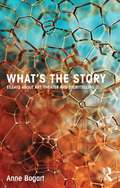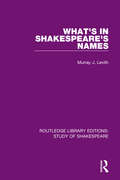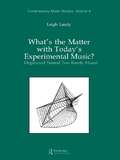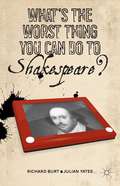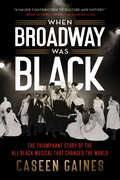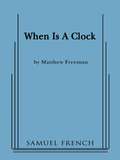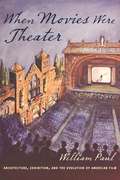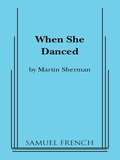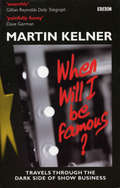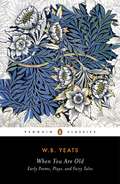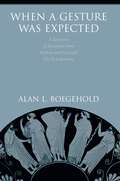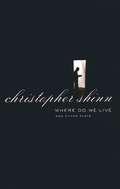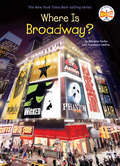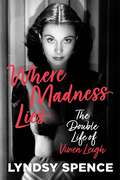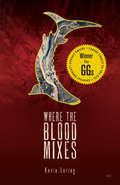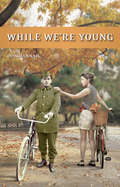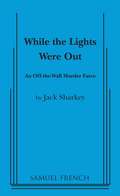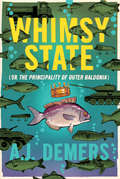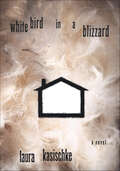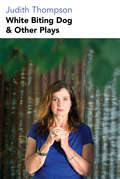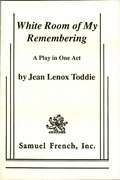- Table View
- List View
What's The Story: Essays About Art, Theater And Storytelling
by Anne BogartAnne Bogart is an award-winning theatre maker, and a best-selling writer of books about theatre, art, and cultural politics. In this her latest collection of essays she explores the story-telling impulse, and asks how she, as a ‘product of postmodernism’, can reconnect to the primal act of making meaning and telling stories. She also asks how theatre practitioners can think of themselves not as stagers of plays but ‘orchestrators of social interactions’ and participants in an on-going dialogue about the future.
What's in Shakespeare's Names (Routledge Library Editions: Study of Shakespeare)
by Murray J. Levith‘What’s in a name? That which we call a rose/By any other name would smell as sweet.’ So says Juliet in the balcony scene from Romeo and Juliet but, originally published in 1978, Murray Levith shows just how wrong Juliet was. Shakespeare was extremely careful in his selection of names. Not only the obvious Hotspur or the descriptive Bottom or Snout, but most names in Shakespeare’s thirty-seven plays had a more than superficial significance. Beginning with what has been written previously, Levith illustrates how Shakespeare used names – not only those he invented in the later comedies, but those names bequeathed to him by history, myth, classical literature, or the Bible. Levith moves from the histories through the tragedies to the comedies, listing each significant name play by play, giving the allusions, references, and suggestions that show how each name enriches interpretations of action, character, and tone. Dr. Levith examines Shakespeare’s own name, and speculates upon the playwright’s identification with his characters and the often whimsical naming games he played or that were played upon him. A separate alphabetical index is provided to facilitate the location of individual names and, in addition, cross references to plays are given so that each name can be considered in the context of all the plays in which it appears.
What's the Matter with Today's Experimental Music?: Organized Sound Too Rarely Heard (Contemporary Music Studies #4)
by Leigh LandyToday's education and communications media are seen to be the main cause of the anonymity of contemporary music and suggestions are made to improve this situation. Leigh Landy investigates audio-visual applications that have hardly been explored, new timbres and sound sources, the discovery of musical space, new notations, musical politics, and the 'musical community' in an attempt to incite more composers, musicians and musicologists to get this music out into the works and to stimulate the creation of new experimental works.
What's the Story: Essays about art, theater and storytelling
by Anne BogartAnne Bogart is an award-winning theatre maker, and a best-selling writer of books about theatre, art, and cultural politics. In this her latest collection of essays she explores the story-telling impulse, and asks how she, as a ‘product of postmodernism’, can reconnect to the primal act of making meaning and telling stories. She also asks how theatre practitioners can think of themselves not as stagers of plays but ‘orchestrators of social interactions’ and participants in an on-going dialogue about the future. We dream. And then occasionally we attempt to share our dreams with others. In recounting our dreams we try to construct a narrative... We also make stories out of our daytime existence. The human brain is a narrative creating machine that takes whatever happens and imposes chronology, meaning, cause and effect... We choose. We can choose to relate to our circumstances with bitterness or with openness. The stories that we tell determine nothing less than personal destiny. (From the introduction) This compelling new book is characteristically made up of chapters with one-word titles: Spaciousness, Narrative, Heat, Limits, Error, Politics, Arrest, Empathy, Opposition, Collaboration and Sustenance. In addition to dipping into neuroscience, performance theory and sociology, Bogart also recounts vivid stories from her own life. But as neuroscience indicates, the event of remembering what happened is in fact the creation of something new.
What’s the Worst Thing You Can Do to Shakespeare?
by Richard BurtWhat's the worst thing you can do to Shakespeare? The answer is simple: don't read him. To that end, Richard Burt and Julian Yates embark on a project of un/reading the Bard, turning the conventional challenges into a roadmap for textual analysis and a thorough reconsideration of the plays in light of their absorption into global culture.
When Broadway Was Black: The Triumphant Story of the All-Black Musical that Changed the World
by Caseen GainesThe triumphant story of how an all-Black Broadway cast and crew changed musical theatre—and the world—forever."This musical introduced Black excellence to the Great White Way. Broadway was forever changed and we, who stand on the shoulders of our brilliant ancestors, are charged with the very often elusive task of carrying that torch into our present."—Billy Porter, Tony, Grammy, and Emmy Award-winning actor"The 1920s were the years of Manhattan's Black Renaissance. It began with Shuffle Along." —Langston HughesIf Hamilton, Rent, or West Side Story captured your heart, you'll love this in-depth look into the rise of the 1921 Broadway hit, Shuffle Along, the first all-Black musical to succeed on Broadway. No one was sure if America was ready for a show featuring nuanced, thoughtful portrayals of Black characters—and the potential fallout was terrifying. But from the first jazzy, syncopated beats of composers Noble Sissle and Eubie Blake, New York audiences fell head over heels.When Broadway Was Black is the story of how Sissle and Blake, along with comedians Flournoy Miller and Aubrey Lyles, overcame poverty, racism, and violence to harness the energy of the Harlem Renaissance and produce a runaway Broadway hit that launched the careers of many of the twentieth century's most beloved Black performers. Born in the shadow of slavery and establishing their careers at a time of increasing demands for racial justice and representation for people of color, they broke down innumerable barriers between Black and white communities at a crucial point in our history.Author and pop culture expert Caseen Gaines leads readers through the glitz and glamour of New York City during the Roaring Twenties to reveal the revolutionary impact one show had on generations of Americans, and how its legacy continues to resonate today.Praise for When Broadway Was Black:"A major contribution to culture."—Brian Jay Jones, New York Times bestselling author of Jim Henson: The Biography"With meticulous research and smooth storytelling, Caseen Gaines significantly deepens our understanding of one of the key cultural events that launched the Harlem Renaissance."—A Lelia Bundles, New York Times bestselling author of On Her Own Ground: The Life and Times of Madam C.J. Walker"Absorbing..."—The Wall Street JournalPreviously published as Footnotes: The Black Artists Who Rewrote the Rules of the Great White Way
When Heroes Sing
by Sarah NooterThis book examines the lyrical voice of Sophocles' heroes and argues that their identities are grounded in poetic identity and power. It begins by looking at how voice can be distinguished in Greek tragedy and by exploring ways that the language of tragedy was influenced by other kinds of poetry in late fifth-century Athens. In subsequent chapters, Professor Nooter undertakes close readings of Sophocles' plays to show how the voice of each hero is inflected by song and other markers of lyric poetry. She then argues that the heroes' lyrical voices set them apart from their communities and lend them the authority and abilities of poets. Close analysis of the Greek texts is supplemented by translations and discussions of poetic features more generally, such as apostrophe and address. This study offers new insight into the ways that Sophoclean tragedy inherits and refracts the traditions of other poetic genres.
When Honour's at the Stake (Routledge Revivals)
by Norman CouncilRenaissance ideas of honour had a profound influence on the English people who formed Shakespeare’s audiences. In When Honour’s at the Stake, first published in 1973, Norman Council describes the increasing importance of these ideas to the themes and structure of a number of Shakespeare’s major plays. The validity of the most widely approved code of honour was being challenged on a variety of fronts, yet both personal standards of behaviour and public affairs were habitually understood in terms of honour. A series of tragedies are given their basic form by dramatizing the pernicious effects of man’s disobedience to the various demands of honour; in Julius Caesar, Troilus and Cressida, Hamlet, Othello, and King Lear honour is among the principal motives of tragedy. In this way, the modern reader’s comprehension of the plays can be greatly enhanced by reference to Elizabethan honour codes.
When Is a Clock
by Matthew FreemanDramatic Comedy / 5m, 3f / Approximate running time: 1 hour and 45 minutes, no intermission. / Various settings, some real, some imaginary, in Pennsylvania / When Gordon's wife vanishes, the only clue to her whereabouts is a bookmark in dog-eared copy of Traveling to Montpelier. With little help to be found at work, from his son, or from the police, Gordon takes off to a rural bookstore to find some answers. His journey brings him to the town of Cornersville, in the wilds of Pennsylvania. Through a fractured narrative that is half-mystery and half-memory, we learn about Gordon’s marriage, his relationship with his son, his work-life and his wife’s bizarre entanglements with a mysterious stranger. We learn, too, about the nature of the landscape unique to the play: a magical universe with physics and laws that can both free the characters from their own stifling identities, and trap them as well. Synchronicity, dreams, and alchemy combine in this exploration of what it means to be able to – and unable to – change. At turns both scathingly funny and disturbingly compelling, When Is A Clock features Freeman's celebrated deconstruction of American culture - which has been called "nonviolent, though as savage as any slasher film" by the New York Times.
When Movies Were Theater: Architecture, Exhibition, and the Evolution of American Film (Film and Culture Series)
by William PaulThere was a time when seeing a movie meant more than seeing a film. The theater itself shaped the very perception of events on screen. This multilayered history tells the story of American film through the evolution of theater architecture and the surprisingly varied ways movies were shown, ranging from Edison's 1896 projections to the 1968 Cinerama premiere of Stanley Kubrick's 2001. William Paul matches distinct architectural forms to movie styles, showing how cinema's roots in theater influenced business practices, exhibition strategies, and film technologies.
When She Danced (Plays Ser.)
by Martin ShermanDrama \ 3m, 5f \ Interior \ New York's Playwrights Horizons had a success starring Elizabeth Ashley as the legendary Isadora Duncan. The acclaimed author of Bent brings us Paris 1923, and Duncan's desperate attempts to keep herself financially solvent to realize her dream of retirement : a school in Italy to teach young dancers her art while distracted by her mercurial husband, a poet who only speaks Russian, as well as various acolytes, through whose eyes we glimpse the greatness of Isadora "when she danced". \ "A fascinating play.... A comic portrait of a Bohemian salon in both joy and extremis, as the calling of high art meets the low farce of insistent creditors, ludicrous lovers and unexpected guests. The very inexplicability of Isadora's art becomes ... a stirring emblem of its mysterious power to endure."- The New York Times
When Will I Be Famous?
by Martin KelnerWhen Will I Be Famous? is about a world of entertainment; a twilight world far from the bright lights of the West End. Among the pages of Showcall, an annual index of artistes and attractions, there is an army of hopefuls waiting for their big break. Some may be on the verge of a big break; for others, the big break came and went years ago. What they all have in common is that they are out there, entertaining people night after night, folding paper into interesting shapes, telling jokes to businessmen at corporate functions, stripping for hen-parties. Together, they represent an unalloyed triumph of hope over experience. Using acts from Showcall as a starting point, Martin Kelner travels from town to town, demonstrating that how we are entertained, what we do for fun, says at least as much about The Way We Live Now as any other indicator. When Will I Be Famous? is a fascinating and funny account of Britain as seen by the people who try to keep it happy.
When You Are Old: Early Poems, Plays, and Fairy Tales
by William Butler Yeats Rob DoggettRecalling Yeats's 1890s fascination in aestheticism and the arts and crafts movement, selections will draw from the first published versions of poems from works such as Crossways, The Rose, The Wind Among the Reeds, In the Seven Woods, The Green Helmet and Other Poems, Responsibilities, The Wild Swans at Coole, and Michael Robartes and the Dancer. A selection Irish myths and fairytales including "The Wanderings of Oisin," a Celtic fable and his first major poem, represent his fascination with mysticism, spiritualism and the rich and imaginative heritage of his native land.
When a Gesture Was Expected: A Selection of Examples from Archaic and Classical Greek Literature
by Alan L. BoegeholdA boldly innovative study of nonverbal communication in the poetry and prose of Hellenic antiquityWhen a Gesture Was Expected encourages a deeper appreciation of ancient Greek poetry and prose by showing where a nod of the head or a wave of the hand can complete meaning in epic poetry and in tragedy, comedy, oratory, and in works of history and philosophy. All these works anticipated performing readers, and, as a result, they included prompts, places where a gesture could complete a sentence or amplify or comment on the written words. In this radical and highly accessible book, Alan Boegehold urges all readers to supplement the traditional avenues of classical philology with an awareness of the uses of nonverbal communication in Hellenic antiquity. This additional resource helps to explain some persistently confusing syntaxes and to make translations more accurate. It also imparts a living breath to these immortal texts.Where part of a work appears to be missing, or the syntax is irregular, or the words seem contradictory or perverse—without evidence of copyists' errors or physical damage—an ancient author may have been assuming that a performing reader would make the necessary clarifying gesture. Boegehold offers analyses of many such instances in selected passages ranging from Homer to Aeschylus to Plato. He also presents a review of sources of information about such gestures in antiquity as well as thirty illustrations, some documenting millennia-long continuities in nonverbal communication.
Where Do We Live and Other Plays
by Christopher ShinnThis anthology marks the emergence of one of the finest and most innovative new artists writing for the theater today. "The secret of Shinn's success is in the way he exploits the dramatic gap between what is said and that which is left unsaid . . . writing like this is rare," said the London Independent. Where Do We Live, the title play, was written shortly after 9/11 and though never referenced, it still haunts this chronicle of the struggles of several aspiring and gifted young New Yorkers on the Lower East Side. Like all his work, it is a deeply affecting story of how we define our lives and our place in the world.The Coming World "Shinn certainly looks like a shining prospect for the future."--Daily TelegraphFour "Nothing is simple emotionally. The play keeps delivering small shocks and aches that end in a standoff, or maybe in that pause between despair, resignation and a twinge of hope. Haunting."--Margo Jefferson, The New York TimesOther People "Shinn writes with graceful compassion about people trapped inside their own skins unable to make sense of their lives."--The GuardianWhat Didn't Happen ". . . is about the distance between people, and the ways in which even friends, spouses and lovers are ultimately unknowable to one another . . . a playwright to cherish."--The New York TimesChristopher Shinn's plays have been produced at Playwrights Horizons, Manhattan Theatre Club, the Vineyard Theatre in New York and often at London's Royal Court Theatre. Where Do We Live received a 2003 Olivier Award nomination for most promising playwright. His next play, On the Mountain, premieres in New York City early in 2005.
Where Is Broadway? (Where Is?)
by Francesco Sedita Douglas Yacka Who HQTake your seats, because Where Is Broadway? is ready to take center stage!In a lively and engaging style, authors Douglas Yacka and Francesco Sedita cover the development of the first theaters and the birth of the American musical, as well as the shows and stars that have become Broadway legends. Readers will get the inside story on their favorite shows and may even discover some new ones.
Where Madness Lies: The Double Life of Vivien Leigh
by Lyndsy SpenceVivien Leigh was one of the greatest film and theatrical stars of the twentieth century. Her Oscar-winning performances in Gone with the Wind and A Streetcar Named Desire have cemented her status as an icon of classic Hollywood.Her meteoric rise to fame launched her into the gaze of fellow rising star Laurence Olivier. A tempestuous relationship ensued that would last for twenty years and captured the imagination of people around the world.Behind the scenes, however, Leigh’s personal life was marred by bipolar disorder, which remained undiagnosed until 1953. Largely misunderstood and subjected to barbaric mistreatment at the hands of her doctors, she also suffered the heartbreak of Olivier’s infidelity. Contributing to her image as a tragic heroine, she died at the age of 53.Where Madness Lies begins in 1953, when Leigh suffered a nervous breakdown and was institutionalised. The woeful story unfolds as she tries to rebuild her life, salvage her career and save her marriage.Featuring a wealth of unpublished material, including private correspondence, bestselling author Lyndsy Spence reveals the woman behind the legendary image: a woman who remained strong in the face of adversity
Where There's a Will There's a Relative
by Roger KarshnerComedy / 3m, 3f / Interior Sam Price, a wealthy entrepreneur, has just recently passed away and, at his request, has been laid out in his townhouse. With the corpse in the bedroom, his immediate family-sister, brother, nephew and niece-have gathered to discuss their inheritance, a meeting that descends into acrimony over the division of property. Much to their chagrin, they learn that Sam has left his entire estate to the church, a discovery that results in them reluctantly seeking the advice of a person they deem to be of unsavory moral character. His advice seemingly solves their dilemma until they realize that the solution involves compromise. Many reversals drive a story that comically reveals avarice, mistrust and chicanery.
Where the Blood Mixes
by Kevin LoringWhere the Blood Mixes is meant to expose the shadows below the surface of the author's First Nations heritage, and to celebrate its survivors. Though torn down years ago, the memories of their Residential School still live deep inside the hearts of those who spent their childhoods there. For some, like Floyd, the legacy of that trauma has been passed down through families for generations. But what is the greater story, what lies untold beneath Floyd's alcoholism, under the pain and isolation of the play's main character?Loring's title was inspired by the mistranslation of the N'lakap'mux (Thompson) place name Kumsheen. For years, it was believed to mean "the place where the rivers meet"-the confluence of the muddy Fraser and the brilliant blue Thompson Rivers. A more accurate translation is: "the place inside the heart where the blood mixes." But Kumsheen also refers to a story: Coyote was disemboweled there, along a great cliff in an epic battle with a giant shape-shifting being that could transform the world with its powers-to this day his intestines can still be seen strewn along the granite walls. In his rage the transformer tore Coyote apart and scattered his body across the nation, his heart landing in the place where the rivers meet.Floyd is a man who has lost everyone he holds most dear. Now after more than two decades, his daughter Christine returns home to confront her father. Set during the salmon run, Where the Blood Mixes takes us to the bottom of the river, to the heart of a People.In 2009 Where the Blood Mixes won the Jessie Richardson Award for Outstanding Original Script; the Sydney J. Risk Prize for Outstanding Original Script by an Emerging Playwright; and most recently the Governor General's Literary Award for Drama.
While We're Young
by Don HannahA young soldier goes to Afghanistan, another to Passchendaele. A family splits in two when a Protestant falls in love with a Catholic; one hundred and twenty years later, it could happen all over again for a whole new set of reasons. From the University of Alberta's inaugural Lee Playwright-in-Residence.
While the Lights Were Out
by Jack SharkeyFarce / 5m, 9f / A Thunderstorm! The lights go out! An agonized voice! A pistol shot! The lights come up! A blonde in black lace stands over the dead man holding a bloody dagger! The detective examines the body and announces "He's been strangled! This is but the opening of one of the most astounding and hilarious murder mysteries ever staged. Every clue is a lulu and the plot twists furiously. The final solution involves the most bizarre motive ever conceived! The delightful evening of mayhem gallops madly about the stage and will leave your audience breathless with surprise and laughter. The mystery is topnotch, the character marvelous and the comedy explosive!
Whimsy State: or The Principality of Outer Baldonia
by A.J. DemersWith a few drinks and some “Ayes!” three fishermen on a small island off the coast of Nova Scotia declare independence from Canada: henceforth, they shall be known as the Princes of the Principality of Outer Baldonia! It’s 1948 when Russ, Elson, and Ron discover that the Canadian government plans to open their Atlantic commercial fishing rights to the Spanish, posing an overcrowding threat to business and wildlife. Russ, a vacationing American lawyer, has just purchased Outer Bald Tusket Island for $750. With a newly erected stone lodge, plenty of fish, two new friends, and just enough frustration about rules and regulations, Russ can do what he pleases, including requesting official recognition from the United Nations for his fledgling state and declaring war on the USSR. Based on an absolutely true story, this hilarious play about friendship shows that when ordinary people set out to do extraordinary things, the possibilities are endless.
White Bird in a Blizzard: A Novel
by Laura KasischkeI am sixteen when my mother steps out of her skin one frozen January afternoon—pure self, atoms twinkling like microscopic diamond chips around her perhaps the chiming of a clock, or a few bright flute notes in the distance—and disappears. No one sees her leave, but she is gone. Laura Kasischke's first novel. Suspicious River. was hailed by the critics as "extremely powerful" (The Los Angeles Times), "amazing" (The Boston Globe), and "a novel of depth, beauty, and insight" (The Seattle Times). Now Kasischke follows up her auspicious debut with a spellbinding and erotic tale of marriage, secrets, and self-deception. When Katrina Connors' mother walks out on her family one frigid January day, Kat is surprised but not shocked; the whole year she has been "becoming sixteen"—falling in love with the boy next door, shedding her baby fat, discovering sex—her mother has slowly been withdrawing. As Kat and her father pick up the pieces of their daily life, she finds herself curiously unaffected by her mother's absence. But in dreams that become too real to ignore, she's haunted by her mother's cries for help. . . .
White Biting Dog and Other Plays
by Judith ThompsonThis book collects some of Judith Thompson’s earlier, hard-to-find plays, including White Biting Dog, a poetic black comedy about a divorced lawyer who prepares to kill himself by jumping off the Bloor Street Viaduct—until he encounters a small dog who sets him on a different path; I Am Yours, a harrowing story about a group of characters on the brink of despair as each tries to escape what haunts them the most; and Pink, a moving monologue set in 1970s South Africa that centres on a young girl’s surprising reaction after her nanny is murdered during a protest.
White Room of My Remembering
by Jean Lenox ToddieDrama / 2m, 4f / Interior / This poignant play by the author of Tell Me Another Story, Sing Me a Song; A Little Something for the Ducks; A Scent of Honeysuckle and A Bag of Green Apples is the story of two women, Margaret and Jessie, who have come to Jessie's childhood home to put it up for sale. While Margaret goes to find a real estate agent, Jessie has conversations with herself as a girl and with her dead father and her mother.
